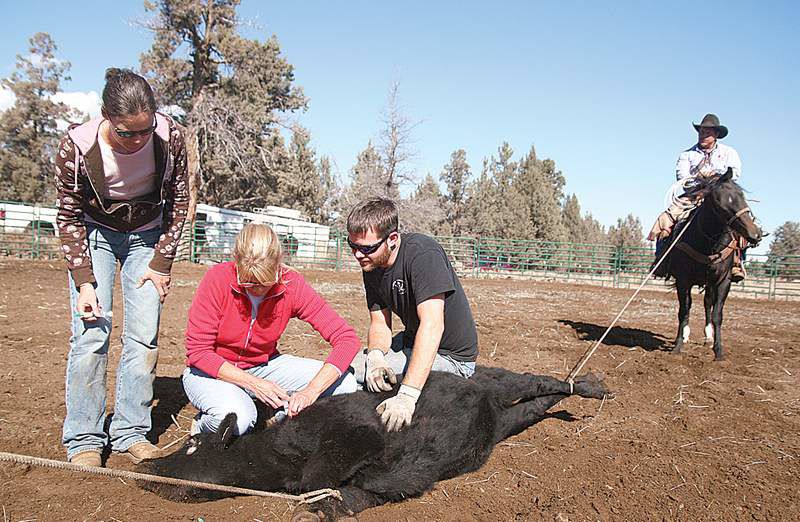Roundup traditions: work and socialize
Published 5:00 am Sunday, October 18, 2009

- Honk McBeth, 42, from Prineville, holds the rope taut while, from left, Trish Odom, Rita Bruton and Jeff Juhl work together to vaccinate a young calf. With the roundup twice a year, the calves and easier to handle.
Taking a break from roping calves on Dave Holmberg’s ranch north of Bend on Saturday, cowboy Shorty Abraham used his fingers to count off the injuries he’s suffered in the past year — a broken back, broken ribs, a broken leg, a dislocated shoulder and a plate installed in his head. Still looking down at his hands, he grinned and said he’s been lucky. By the time most cowboys are Abraham’s age — he’s 74 — they have lost at least a finger or two, he said.
“I feel good,” Abraham said. “I can do this for a week at a time.”
Holmberg, 57, has hosted a roundup twice a year for 20 years, working with winter-born calves in the spring and summer-born calves in the fall. Calves are branded, and their horns are clipped. Then, they are vaccinated, and the males are castrated. By holding the roundup twice a year, participants avoid tangling with larger animals older than 6 months.
The event is as much social as it is work, with plenty of time for visiting, and a leisurely barbecue lunch at midday. Several of the ropers and helpers at Saturday’s roundup have been coming for 10 years or more, Holmberg said.
“There’s sort of a reciprocal arrangement; Shorty had a ranch, Honk (McBeth) has a ranch,” Holmberg said. “It kinda goes back to the old days, like the Amish barn-building tradition. If one farmer needed a barn built, everyone would come to help them.”
The principal of Marshall High School in Bend, Holmberg fits comfortably in the role of weekend cowboy, according to Carl Juhl, owner of most of the cattle at the roundup.
“He’s got a Ph.D., and he’s out here in the mud just like me,” Juhl said. Holmberg clarified that, in fact, he only has a master’s degree.
Raised on a ranch near Eugene, Juhl served in World War II, went to Oregon State University and took a job with the U.S. Forest Service. Juhl started dabbling in ranching in the late 1960s, then took it up full time after he retired from the Forest Service in 1981, running as many as 200 animals at a time.
“My wife tells me, ‘Why don’t you get rid of your cattle and do something else?’” said Juhl, 83. “I’m getting to the age where I don’t think anybody else is going to hire me.”
Juhl said he prefers the old-fashioned roundup to the more modern way of securing calves. Rather than roping, many ranchers now use a calf table, an assembly that looks like the frame from a foldout bed and is used to grab the animal as it walks out the end of a chute. Juhl said if he bought a calf table, he doubted his friends would be quite so interested in helping out.
Many of the ropers at Holmberg’s ranch Saturday are rodeo competitors who use the event as practice.
For Abraham, the experience is mostly about the thrill he gets out of riding and working cattle. Even now, he still rides an estimated 600 miles a year.
“This is a lot more fun than ranching. You don’t have to worry about the price of cattle or how many calves you’re gonna lose or how cold it is. You just come out here and have fun and eat good.”
Saturday’s roundup featured one low note. One roper was thrown from her horse, and in the chaos that followed, the horse broke its leg and had to be put down. Holmberg said such events are extremely rare — no one has been hurt at the roundup since a calf kicked him in the teeth five years ago — but accidents will happen, he said.
“I’ve never seen anything like that after 30 years of working in agriculture.”






